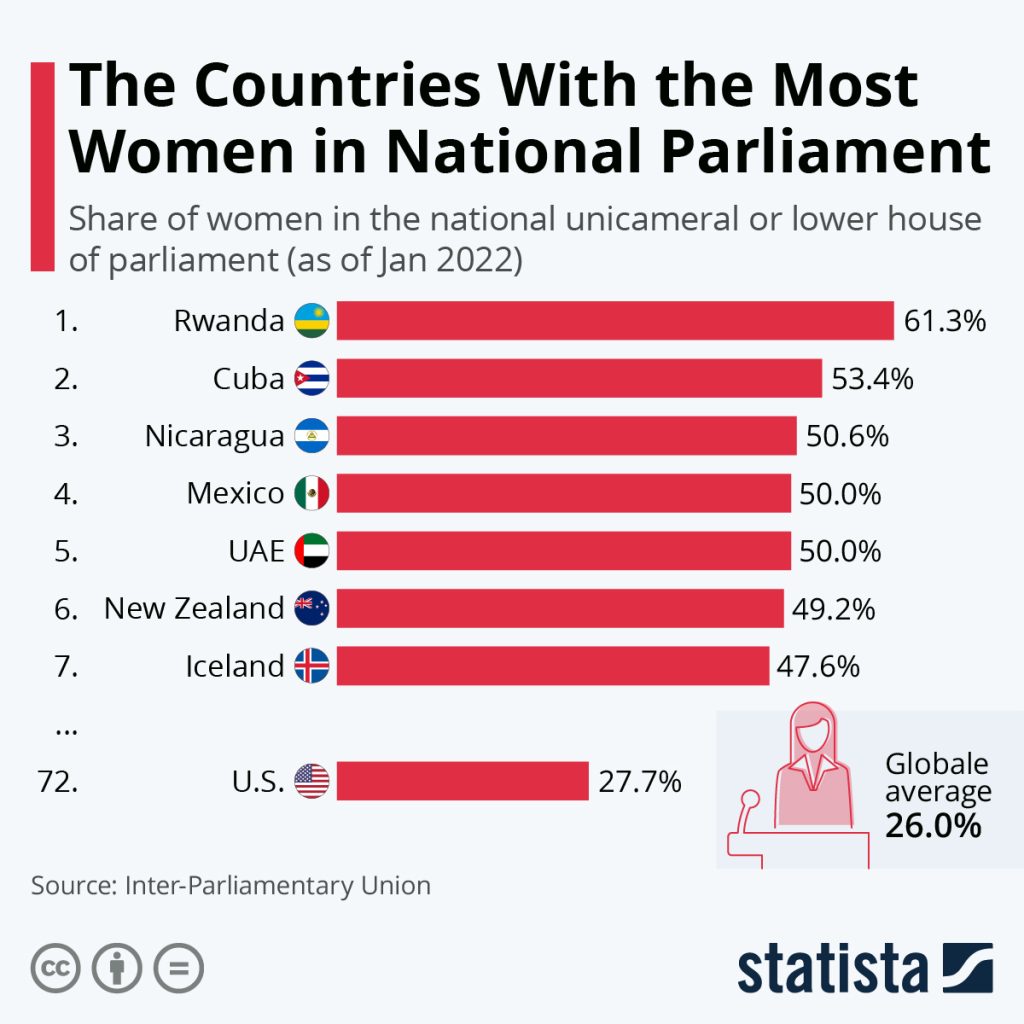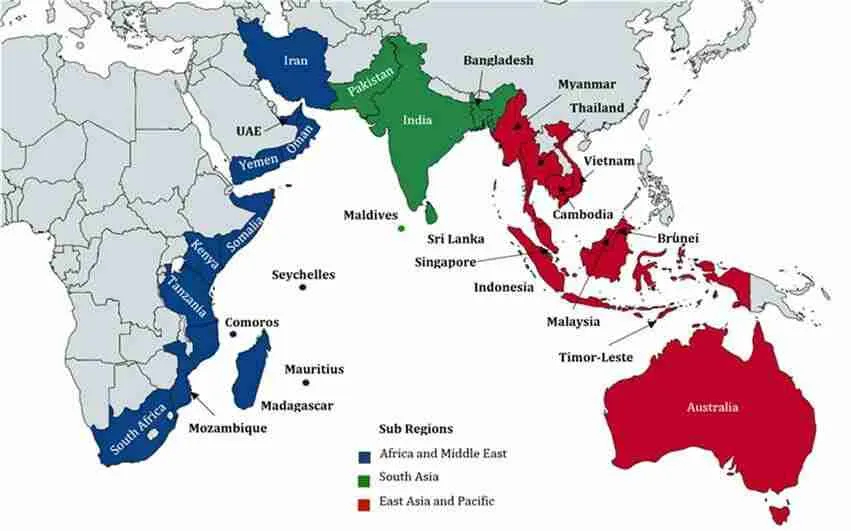CONTENTS
- Gender Bias in Politics is a Crude Reality
- All Eyes are on the Indian Ocean Region
Gender Bias in Politics is a Crude Reality
Context:
Donald Trump emerged victorious in the South Carolina primary, surpassing Nikki Haley, the final significant Republican contender vying for the Presidential nomination. Ahead of the election, a Republican supporter from South Carolina remarked that while Ms. Haley had accomplished commendable feats as governor, Donald Trump was deemed the preferred choice as he was a man, echoing the prevailing sentiment among the public. This prompts an inquiry into whether there exists a discernible bias favoring male candidates over female candidates.
Relevance:
GS-1
Role of Women
GS-2
- Issues Related to Women
- Government Policies & Interventions
GS3-
- Inclusive Growth
- Human Resource
Mains Question:
Analyse how rampant is the issue of gender bias in politics at the global and national levels. What can be done to ensure more female representation in political systems around the world? (15 Marks, 250 Words).
Global Studies on Gender and Voter Preferences:
- According to a study conducted by a political science professor at Ohio University in 2000 many voters tend to factor gender into their assessments of candidates, using it as a gauge for predicting a candidate’s beliefs and competence. These subtle biases, present in certain electoral contests, can disadvantage a candidate based on their gender.
- Research conducted on French parliamentary elections revealed that in municipalities with more traditional gender-role attitudes, votes for women tend to be lower (Barbanchon and Sauvagnat, 2019).
- However, a study in 2018 argued that the impact of gender on voting patterns is strongly influenced by how individuals identify with masculinity and femininity, which can vary depending on where one positions themselves on a masculinity/femininity continuum.
- The study noted that many men who do not strongly adhere to hyper-masculine ideals may hold liberal views on various issues, while conversely, many highly feminine women with traditional gender identities may lean conservative on certain issues. Therefore, the study suggests that gender cannot be automatically considered a primary or overarching identity.
- Additionally, there is a competing perspective that argues gender does not significantly influence voting behavior or political attitudes, with minimal differences observed between men and women in their attitudes and voting choices (Amanda Bittner, University of Newfoundland & Elizabeth Goodyear-Grant, Queen’s University, 2017).
Global Status of Women in Politics:
- In Spain, following the implementation of a law in 2007 mandating political parties to include at least 40 percent women on every election list, a study found no evidence indicating that this policy exacerbated women’s relative electoral performance or resulted in lower voter support for women due to external factors (Bagues and Campa, 2020).
- However, during the 2018 midterms in the USA, sex and gender did emerge as significant factors, leading to substantial partisan gaps between men and women in their voting patterns.
- Furthermore, a study conducted in India revealed that a “woman voter” is more inclined to support a male candidate than vice versa, suggesting that societal perceptions rather than candidate suitability often influence voting decisions.
- According to data gathered by the Inter-Parliamentary Union (IPU), women constitute 14.44% of the members of the 17th Lok Sabha in India.
- Based on the most recent report from the Election Commission of India (ECI), as of October 2021, women make up 10.5% of all Members of Parliament.
- Across all state assemblies, the average representation of female MLAs stands at 9%.
- India’s ranking in terms of female political representation has declined in recent years, with the country currently trailing behind Pakistan, Bangladesh, and Nepal in this regard.

Reasons Behind Under-Representation of Women in Electoral Politics:
- Unfortunately, the under-representation of women in electoral politics remains a stark reality. According to the World Economic Forum’s Gender Equality Report, only 25% of the potential 100% gender gap in women’s political participation has been closed thus far.
- Many political scientists attribute this gap to constraints in both the supply and demand aspects, citing a shortage of potential female candidates and a perceived lower appeal of women politicians in electoral contests.
- Various socio-economic and cultural barriers further deter women from entering politics, leading to a higher opportunity cost associated with running for office (Fox et al., 2001).
- Additionally, women are often underrepresented in professions that serve as pathways to political careers. Studies have also identified an “ambition deficit” among women, despite possessing the necessary professional and economic qualifications, as many hesitate to engage in competitive political arenas (Niederle and Vesterlund, 2007; Fox and Lawless, 2004).
- Family and relationship considerations also discourage women from pursuing political roles, with recent research from Sweden indicating that female politicians in mayoral positions face an increased likelihood of divorce (Folke and Rickne, 2020).
- Furthermore, women frequently encounter discouragement and discrimination in political spheres, often being told they do not belong, which reflects a systematic gender hierarchy within politics.
- Sexism among party leaders exacerbates this issue, particularly when they perceive voter bias against women and prioritize maximizing votes as a strategy.
- In the 2019 Indian elections, although there was a noticeable increase in the turnout of women voters, the proportion of women candidates remained below 9%. Those who did secure party nominations often had familial political ties or were considered “dynastic” politicians.
- Despite the implementation of gender quotas at Panchayati Raj Institutions (PRIs), there hasn’t been a significant increase in the number of women candidates at the state level.
Recent Developments:
- A study by Bhalotra et al. (2018), analyzing electoral data from 1980 to 2007, revealed that a woman’s electoral victory results in an 18.5 percentage point higher likelihood of another woman being fielded as a major party candidate in the subsequent election.
- As of November 2021, gender quotas have been adopted in 132 countries, either as voluntary party measures or compulsory legislative quotas. A study spanning from 1995 to 2012 showed that such measures led to an increase in women’s representation from 11% to 21%.
- In India, the Women’s Reservation Bill was passed in 2023, emphasizing the urgency of its implementation without further delay.
Conclusion:
Critics argue that these quotas are “anti-democratic” and manipulate voters’ choices, while some women’s rights activists view them as disrespectful assumptions that women cannot secure seats on their own, often labeling women beneficiaries as “quota women.” Nevertheless, these measures have propelled women into political spheres in many least-developed countries such as Rwanda, Uganda, and Tanzania, enhancing their substantive representation on traditionally gendered issues.
All Eyes are on the Indian Ocean Region
Context:
While the Indian government’s primary focus from January 2021 centered on the Indo-Pacific region, with a concerted effort to bolster the Quad alliance, policy emphasis has reverted to the Indian Ocean since October 2023. Although the Indo-Pacific strategy encompasses both the Pacific and Indian Oceans, during times of heightened peril, the immediate neighborhood assumes greater significance than distant shores.
Relevance:
GS2-
- Groupings and Agreements Involving India and/or Affecting India’s Interests
- Regional Groupings
- Important International Institutions
- International Treaties & Agreements
Mains Question:
Both the Western and Northern Indian Ocean have become active geographies again. In this context, discuss India’s current approach in the Indian Ocean Region and suggest a way forward strategy in this regard. (15 Marks, 250 Words).
Various Dimensions of the Indian Ocean Region and India’s Respective Positions:

Maldives:
The change in policy in the Maldives, under President Mohamed Muizzu’s leadership, appears to be causing friction with India. Despite New Delhi’s patience and diplomatic approach, Male continues to strengthen its ties with China.
Mauritius:
Last month, India’s SAGAR policy yielded a significant benefit as the Prime Ministers of India and Mauritius inaugurated a new airstrip and jetty in the Agaléga Islands, enhancing Mauritius’s ability to combat illicit activities in its extensive Exclusive Economic Zone.
Sri Lanka:
Sri Lanka has demonstrated greater consideration for India’s security worries by implementing a year-long ban on foreign research vessels, including those from China, accessing its ports.
Western Indian Ocean:
- Western Indian Ocean, extending from the Arabian Sea to the Suez Canal, have become active regions once again.
- This is evidenced by the gradual regionalization of the conflict between Israel and Hamas, as seen in the attacks by Houthi rebels on international shipping, resulting in a significant decrease in transits through the Suez Canal.
- As a consequence, the redirection of ships to the longer route around the Cape of Good Hope negatively impacts all nations in the area, regardless of their size.
- This series of developments is expected to enhance the Chinese Navy’s presence in the region, with the overarching goal of asserting dominance.
- With the Maldives showing willingness to cooperate, Beijing wasted no time in announcing a new agreement, offering unspecified military assistance to the Maldives at no cost.
- This announcement coincided with the replacement of 88 Indian military personnel, who were authorized by the host nation to conduct humanitarian flights using three aviation platforms, with a civilian group.
China:
- The strategic rivalry between China and India is escalating. China relies heavily on the region for its trade and energy supplies, which underscores the importance of securing its supply routes.
- However, concerning is China’s strategic aim to undermine India’s security by alienating its neighboring countries.
- A discernible pattern is emerging as Beijing seeks naval bases in Djibouti, Kyaukphyu, Gwadar, and Hambantota.
- This, coupled with the prolonged border standoff spanning almost four years and defying diplomatic resolution, has perpetuated the adversarial relationship between the two nations.
- India’s defense secretary recently remarked that India has been confronting a determined “bully” both at the border and in the Indo-Pacific region, where a significant moment is unfolding.
- He emphasized that India and the U.S. are crucial stakeholders in the Indo-Pacific, cooperating to address the strategic competition posed by China.
- Collaboration in underwater domain awareness has been identified as a key strategy in countering these emerging threats.
The United Kingdom, European Union, France, and Germany:
- Given their geographic proximity to the region, it is imperative for them to adopt a clear stance on China’s activities.
- While they express concerns about Beijing’s unlawful claims in the South China Sea, they must also recognize a similar trend of assertiveness and hostile intentions emerging in the Indian Ocean.
- Each of these actors seeks closer economic and security ties with India, and progress in this direction is being made gradually. However, they exhibit a deliberate ambiguity when assessing China’s actions and its underlying long-term motives.
- The geographical distance of European nations from China may instil a false sense of security, prompting a reevaluation of their fundamental strategies concerning Asia.
- However, whether they will undertake such a reassessment, given their heightened focus on conflicts in Ukraine and Gaza, remains uncertain.
- Recent engagements with European officials and scholars offer limited optimism, underscoring the ongoing necessity to persuade them of the importance of this matter.
Way Forward:
- Initially, India must articulate a clear message to its strategic allies, affirming its awareness of its Indo-Pacific obligations while emphasizing its prioritization of the Indian Ocean region.
- Secondly, a comprehensive evaluation of the Indian Ocean Rim Association (IORA) and the Colombo Security Conclave (CSC) is imperative. While IORA’s effectiveness has dwindled, rendered too vague to yield significant impact, the CSC confronts the risk of losing a crucial member, the Maldives, should the island nation deepen its ties with China.
Conclusion:
New Delhi may consider advocating for the establishment of a fresh mechanism aimed at enhancing maritime security and leveraging the potential of the Blue Economy. As India aspires to become the world’s third-largest economy, it should allocate additional budgetary resources to enhance its Navy’s capabilities, aiming to elevate it to the position of the third or fourth strongest naval force globally.





